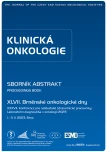Cardiovascular pharmacotherapy in patients with triple negative breast cancer before and after anthracycline treatment
Authors:
A. Bartáková 1; I. Koloušková 2; M. Holánek 2; I. Selingerová 3; T. Stračina 1; T. Kazda 4; M. Nováková 1
Authors‘ workplace:
Fyziologický ústav, LF MU Brno
1; Klinika komplexní onkologické péče LF MU a MOÚ Brno
2; Výzkumné centrum aplikované molekulární onkologie, MOÚ Brno
3; Klinika radiační onkologie LF MU a MOÚ Brno
4
Published in:
Klin Onkol 2023; 36(Supplementum 1): 123-126
Category:
Article
doi:
https://doi.org/10.48095/ccko2023S123
Overview
Cardiovascular diseases represent the leading cause of death in developed countries. Cancer holds the second place in global statistics. Patients are often diagnosed with both these diseases, parallel pharmacological therapy of which brings about the probability of drug interactions. This may affect not only the anticancer treatment, but also the patient’s quality of life and prognosis. The paper presents retrospective analysis of data from 243 patients, with emphasis on the incidence of cardiovascular diseases and associated pharmacotherapy in patients diagnosed with triple negative breast cancer. All subjects were treated with neoadjuvant anthracycline chemotherapy at Masaryk Memorial Cancer Institute between 2015 and 2022. The cohort was characterized by following parameters: age, BMI, arterial blood pressure, left ventricular ejection fraction, ECG parameters including QTc assessment, diagnosed cardiovascular diseases, and regular medications taken before and shortly after anthracycline treatment. The analysis revealed that the most frequent cardiovascular disease was hypertension (45 patients before and 52 after chemotherapy). Before chemotherapy, the most frequently used antihypertensives were calcium channel blockers (19 patients), followed by ACE inhibitors (18 patients), ATII antagonists (17 patients), b-sympatholytic drugs (16 patients), and diuretics (12 patients). After completion of chemotherapy, b-sympatholytic drugs (24 patients) dominated in the treatment of hypertension, followed by calcium channel blockers (23 patients), ATII antagonists (19 patients), ACE inhibitors (17 patients), and diuretics (11 patients). Results of these retrospective study analyses were used to design a whole-body animal model focused on evaluation of the complex reactions of cardiovascular system to polytherapy of anthracyclines and antihypertensive drugs. The follow-up project will focus on the simultaneous effects of b-sympatholytic drugs and calcium channel blockers. The follow-up project mainly aims to evaluate the potential cardioprotective effect of antihypertensives during anthracycline therapy.
Keywords:
cardiotoxicity – anthracyclines – triple negative breast cancer
Sources
1. Jurgens CY, Lee CS, Aycock DM et al. State of the science: the relevance of symptoms in cardiovascular disease and research. Circulation 2022; 146 (12): e173–e184. doi: 10.1161/CIR.0000000000001089.
2. Cong L, Ren Y, Hou T et al. Use of cardiovascular drugs for primary and secondary prevention of cardiovascular disease among rural-dwelling older Chinese adults. Front Pharmacol 2020; 18: 11. doi: 10.3389/fphar.2020.608136.
3. Debela D, Gy Muzazu S, Heraro KD et al. New approaches and procedures for cancer treatment: current perspectives. SAGE Open Med 2021; 12 (9): 20503121211034366. doi: 10.1177/20503121211034366
4. Holanek M, Selingerova I, Bilek O et al. Neoadjuvant chemotherapy of triple-negative breast cancer: evaluation of early clinical response, pathological complete response rates, and addition of platinum salts benefit based on real-world evidence. Cancers 2021; 13 (7): 1586. doi: 10.3390/cancers13071586.
5. Navrátil J, Fabian P, Palácová M et al. Triple negative breast cancer. Klin Onkol 2015; 28 (6): 406–415. doi: 10.14735/amko2015405.
6. Fojtu M, Gumulec J, Stracina T et al. Reduction of doxorubicin-induced cardiotoxicity using nanocarriers: a review. Current Drug Metabolism 2017; 18 (3): 237–263. doi: 10.2174/1389200218666170105165444.
Labels
Paediatric clinical oncology Surgery Clinical oncologyArticle was published in
Clinical Oncology

2023 Issue Supplementum 1
Most read in this issue
- I. Onkologická prevence a screening
- XIX. Nádory tlustého střeva a konečníku
- X. Nežádoucí účinky protinádorové léčby a podpůrná léčba
- III. Follow-up, sledování onkologických pacientů
